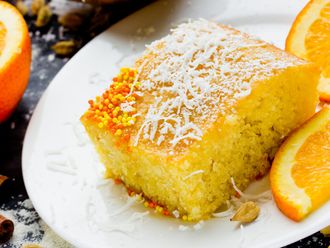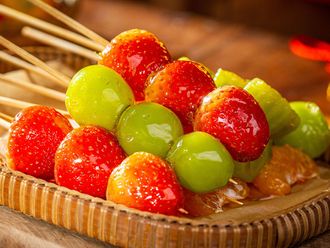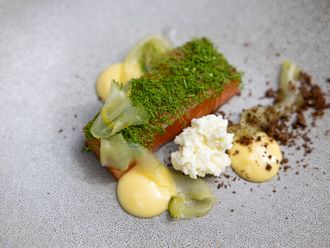Did you know there are two world doughnut days in a year? One falls in the summer month of June, whereas one’s today! However, as you indulge in one of the tastiest treats out there, there’s quite a tale behind it. Especially, since its origins remain obscure.
Early traces of doughnuts are there in Dutch culinary records, where these fried yet sweet buns were called making ‘oly koeks’, or oil cakes, as early as the mid-19th century. These first treats were balls of cake fried in fat until they turned golden brown.
Since the interior of the doughnut did not cook as fast as the exterior, they were usually made with a variety of fillings such as nuts, fruits, creams, or anything that didn’t require a lot of cooking. Soon after the Dutch began to settle in the United States, they continued making ‘oly koeks’, which soon got reinterpreted as doughnuts.
So, how did it get the hole in the middle?
In 1847, a Maine ship Captain Hansen Gregory, who on his dissatisfaction of the doughnuts true form, took it upon himself to take the cover off the ship’s tin pepperbox and cut into the middle of a doughnut. And doughnuts as we know today were born!
Soon after this, his inspiration and discovery led him to tell the townspeople, who later adapted to his technique of making doughnuts. However, it was only during the 1920s that Adolph Levitt, a Russian-born immigrant, invented the first automated doughnut machine and showcased it at the World Expo of 1934 in Illinois, Chicago.
Why are there two doughnut days?
During World War I, troops were assigned female volunteers who prepared food to deliver to soldiers on the frontlines of France. The Salvation Army (an international charitable organisation) dispatched over 250 women, who used battle-tested helmets to fry a maximum of seven doughnuts in one frying. Soon after this, the organisation decided to honour these “doughnut lassies” by declaring an annual pastry holiday to raise awareness for their efforts during the war. Thus, ‘doughnut day’ was born. However, this is celebrated in June.
The November celebration first came about because of US-based food blogger John Bryan Hopkins – who also runs the popular website Foodimentary – at the beginning of 2006.
Why? Mentions of a doughnut day were found in records that dated back to the 1930s, as researched by Hopkins. He speculated that the November 5 date is close enough to Veterans Day, which falls on the eleventh of the same month.
However, nobody is complaining; even if the year has two or three doughnut days, that is reason enough to eat it heartily, or better yet, make it at home. Here is an easy recipe to making festive gold leaf jam doughnuts from Bread Ahead Bakery located at the Mobility District in Expo 2020 Dubai.
Preparation time: 24 hours
Cooking time: 2 hours 30 minutes
Serves: 6
Ingredients:
For the doughnuts:
- 170 gms strong white (bread) flour
- 15 gms caster (superfine) sugar
- 5 gms fresh yeast (or 3 gms dried)
- 3 gms fine sea salt
- ¼ lemon zested
- 1 medium egg (50 gms)
- 40 gms water
- 40 gms unsalted butter, softened
- 2 ltr oil
- Caster sugar for dusting
For the vanilla cream filling:
- 1 vanilla pod
- 500 gms milk
- 6 egg yolks
- 125 gms caster sugar
- 60 gms plain flour
- 125 gms double cream
- 60 gms caster sugar
For raspberry jam:
- 500 gms raspberries (fresh or frozen)
- 450 gms caster sugar
- 8 gms pectin powder (optional)
- 1 lemon, juiced
Method:
Note: Complete this the night before you want to fry your doughnuts.
- Bring all of the dough ingredients apart from the butter together in a bowl, tip onto the table, and using the heel of your hand, knead the dough for about eight minutes.
- Let the dough rest for one minute.
- Continue to knead the dough, adding the butter a quarter teaspoon at a time, until it is all incorporated.
- Knead the dough for a further five minutes until it is glossy, smooth and very elastic when pulled. Return your dough to the bowl, cover with cling film or a plate and leave to prove until it has doubled in size
- Once doubled in size, knock back the dough, then re-cover the bowl and place in the fridge to chill overnight.
If using a food processor:
- Bring all of the dough ingredients apart from the butter together using the dough hook attachment.
- Let the dough rest for one minute, take care that it doesn’t overheat – the machine needs to rest as well as the dough!
- Start it up again on a medium speed and slowly add the butter to the dough – about a quarter teaspoon at a time.
- Once it is all incorporated, mix on high speed for five minutes. Return your dough to the bowl, cover with cling film or a plate and leave to prove until it has doubled in size.
- Once doubled in size, knock back the dough, then re-cover the bowl and put into the fridge to chill overnight.
For the vanilla cream filling:
- Slit the vanilla pod, open lengthways and scrape out the seeds.
- Put the seeds, pod and milk into a heavy-based saucepan and bring slowly to the boil, to infuse the vanilla.
- Meanwhile, place the egg yolks and 125g of the sugar in a bowl and mix together for a few seconds, then sift in the flour and mix together.
- Pour the boiling milk over the yolk mixture, whisking constantly to prevent curdling, then return the mixture to the saucepan and cook over a medium heat, whisking constantly for about 3 minutes, until nice and thick.
- Pass through a fine sieve, then place a sheet of cling film or a sprinkling of caster sugar on the surface of the custard to prevent a skin forming (don’t forget to keep your vanilla pod – wash and dry it to use again).
- Leave the custard to cool, then refrigerate. Whip the cream and remaining 60g of sugar together until thick and fold into the chilled custard. You're ready to pipe!
Note: you can halve this recipe to fill 10 doughnuts or use the leftover custard to fill fruit tarts, use as a filling for a brioche loaf and bake it or spread onto puff pastry, layer with fruit and bake.
For the raspberry jam:
- Put all of your jam ingredients in the saucepan, over a medium heat, stir the mixture together.
- Once the sugar has dissolved, bring to a boil and then simmer for 5 minutes until thickened.
- To test whether or not your jam has reached setting point, take a teaspoon of jam and place it on a chilled plate. Allow to cool, then run your finger through and if it doesn't run back onto itself, the setting point has been reached.
- Alternatively, once the jam is boiling, use a digital thermometer to measure the temperature until it reaches 105C (220F), this is the setting point.
- Take the pan off the heat and leave for 10 minutes, then whisk the foam on the top back into the jam and pour into warmed, sterilised jars.
Note: If you're making jam without pectin, simply add half a grated apple to your jam mixture. The natural pectin in the apple will help to set the jam.
For frying doughnuts:
- The next day, take the dough out of the fridge and cut into 50g pieces (you should get about six).
- Roll them into smooth, tight buns and place them onto an oiled baking tray, leaving plenty of room between them as you don’t want them to stick together while they prove.
- Cover lightly with cling film and leave for about two hours, or until about doubled in size.
- Get your deep-fat fryer ready or get a heavy-based sauce pan and fill it up to the halfway point with oil (please be extremely careful, as hot oil is very dangerous). Heat the oil to 180C (350F). When the oil is heated to the correct temperature, carefully remove the doughnuts from the tray by sliding a floured pastry scraper underneath them, taking care not to deflate them, and put them gently into the oil.
- Do not overcrowd the fryer – do 2 to 3 per batch, depending on the size of your pan. Fry for two minutes on each side until golden brown – they puff up and float.
- Remove from the fryer and place on kitchen paper, then toss them in a bowl of caster sugar while still warm.
- Repeat until all are fried, but make sure the oil temperature is correct every time before you fry – if it is too high they will colour too quickly and burn, and will be raw in the middle.
- If the temperature of the oil is too low, it will be absorbed into the doughnut and it will become greasy. Set aside to cool before filling.
- To fill the doughnuts, make a hole in the crease of each one (anywhere around the white line between the top and bottom).
- Fill a piping bag with your desired filling and pipe into the doughnut until swollen.
- The doughnuts are best eaten right away. Serve and joy!
Do you have a doughnut recipe you would like to share? Email us on food@gulfnews.com














